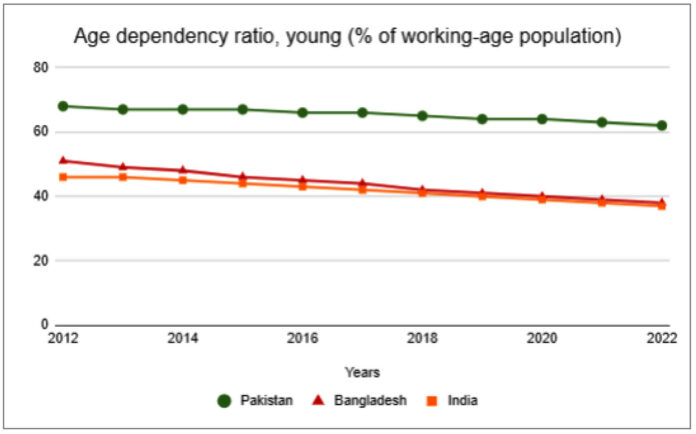The scarcity of employment opportunities for young people will increase the age dependency ratio, which currently stands at 62 percent whereas in India and Bangladesh, it hovers around 37 percent and 38 percent, respectively.
Young people are the future of a nation. They represent potential employees, investors, buyers and driving forces behind business development. Their presence in the skilled labour force will invigorate the economy. Moreover, the involvement of young people is indispensable for businesses to innovate and compete on a global scale.
However, there are meagre employment opportunities for them which increases unemployment. As per the International Labour Organisation (ILO), there are approximately 73 million unemployed youth globally despite being educated. The scenario of unemployment among young people is not different as per the World Development Indicator (WDI), 11.3 percent of youngsters are unemployed and the percentage of unemployment between males and females is 10.3 percent and 14 percent, respectively. However, the Pakistan Institute of Development Economics (PIDE) has found that 31 percent of educated youth are unemployed. Within this group, female unemployment is particularly concerning at 51 percent, while male unemployment is at 16 percent. This report underscores the fact that many unemployed youths possess professional degrees. Surprisingly, a substantial portion of the working-age population remains detached from the labour force, either due to discouragement or alternative income sources.
The government should implement a comprehensive curriculum reform to align education with industry needs and include youth representatives in the policy-making process. It is the situation of now and never. There is a need to accommodate the youngsters and shape a future where every young mind finds purpose; every skill finds canvas and opportunity to grow and earn
On the other hand, as we can see in the graph, age dependency ratio in youngsters remains high in Pakistan that is, 62 percent in 2022 as compared to India (37 percent) and Bangladesh (38 percent). We should keep in mind that Pakistan is the fifth most populous country in the world. It is expected that by 2100 its population will grow to 310 million. As per the National Human Development Report, 64 percent of the population in our country is below the age of 30, which means we have a high youth bulge. This flock of young people can be an opportunity for the country but due to economic and environmental crises, it may turn into a demographic bomb instead of a demographic dividend. The government has to nod its head towards this imminent tide, if the appropriate measure will not be taken then the graph below replaces young people figures with the old age population till 2050 else there will be a massive brain drain. It was calculated by PIDE, 67 percent of the young people wanted to leave Pakistan and only in the first six months of the year 400,000 qualified people had already left the country.
Employment can be generated by industrialisation and fostering a startup culture. Pakistan’s industrial sector has been hampered by a severe energy crisis, and those industries that endure are operating below optimal capacity. In contrast to global trends where countries leverage Artificial Intelligence and technology to enhance production, Pakistani industries struggle to meet consumer demands.
Startups present a beacon of hope, potentially creating 15 percent of employment opportunities. In Pakistan, every year 90 percent of start-ups fail whereas in India 80 percent of the startup fails within five years. In Pakistan, startups are struggling to sustain themselves because entrepreneurs’ lack comprehensive vision, shortage of product market fit, complex rules and regulations, flawed Venture Capital funding, foresightedness, and copying the ideas without investing time in market-based research to give solutions to the problems. Nonetheless, these problems can be handled if national universities design curricula with a focus to elevate entrepreneurial skills by merging practical-based knowledge of business ecosystems into courses.
Let’s take a look at what India and Bangladesh are doing to generate employment opportunities for youngsters. Bangladesh has initiated the ‘Youth Entrepreneurship Development Program’ which aims to provide mentorship, training, and access to finance to young entrepreneurs; ‘E-commerce Training Hubs’ which give training about digital marketing, logistics and customer which helps to grow the retail market and jobs and ‘Startup Incubation Village’ set up the clusters of incubation space in the rural areas to uplift local startups.
The Indian government has also taken initiatives for increasing employment such as Mahatma Gandhi National Rural Employment Guarantee Act (MGNREGA) is a providing a safety net for rural youth by enforcing wage employment for them; ‘Digital India’ is one concept that promotes digital technology and connectivity and creates employment in the sectors like digital marketing, e-commerce and IT; ‘Rural Technology Hubs’ that provide IT and freelancing training to rural people; ‘Entrepreneurship Grants for Students’, this initiative provide loan to college students who have innovative business ideas but have no funds to finance it.
The government of Pakistan can also take steps to increase employment opportunities for young people and take full advantage of their skills to uplift the economy of the country. For instance, the government can launch targeted micro-financing initiatives to help youth start small businesses and a national startup incubation network, providing shared office spaces, mentoring, and access to a market resource, establish a national job placement and training program that connects young job seekers with employers, create hubs and technology parks in urban and rural areas, offer tax incentives to companies generating substantial youth employment specifically micro-enterprises and SMEs.
The government needs to make strategies to create a government-backed venture capital fund dedicated to funding early-stage startups led by youth, simplify the VC funding application process, and establish a regulatory sandbox for startups, allowing them to test their innovative ideas without facing stringent regulations and to develop public-private partnerships to create apprenticeships.
Along with these reforms, the government should implement a comprehensive curriculum reform to align education with industry needs and include youth representatives in the policy-making process. It is the situation of now and never. There is a need to accommodate the youngsters and shape a future where every young mind finds purpose; every skill finds canvas and opportunity to grow and earn.























